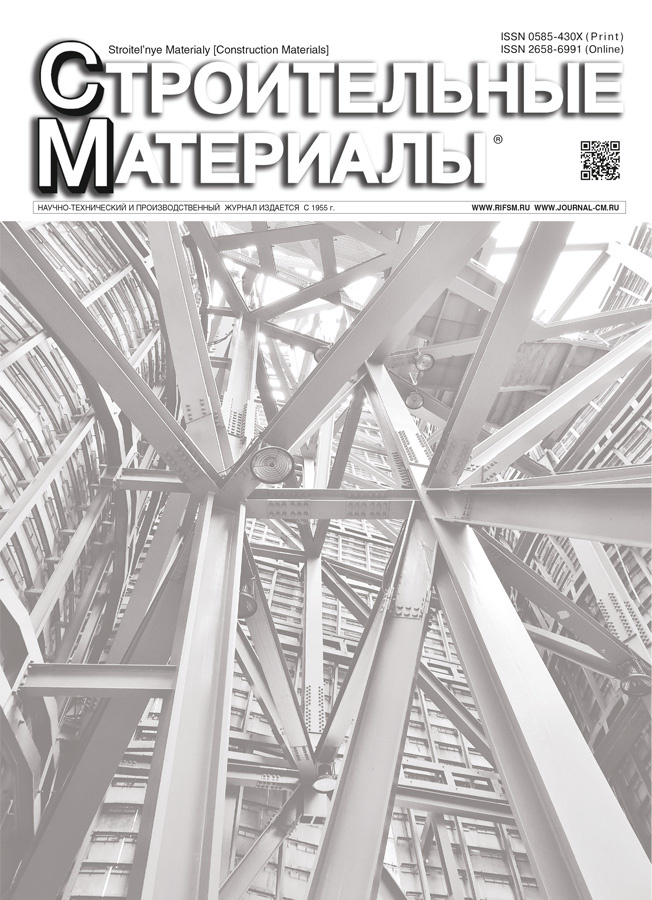Technological and Operational Properties of Filling Epoxy Foam Plastics for Construction Purposes
- Авторлар: Ushkov M.V.1, Samchenko S.V.1, Kopytin A.V.2, Agafonova N.Z.1, Ushkov V.A.1
-
Мекемелер:
- National Research Moscow State University of Civil Engineering
- Federal Standardization Center
- Шығарылым: № 8 (2025)
- Беттер: 47-54
- Бөлім: Статьи
- URL: https://rjdentistry.com/0585-430X/article/view/690210
- DOI: https://doi.org/10.31659/0585-430X-2025-838-8-47-54
- ID: 690210
Дәйексөз келтіру
Аннотация
The influence of the chemical nature and content of aliphatic polyamines and reactive modifiers on the technological and physical-mechanical properties, heat resistance and flammability of casting epoxy foam plastics for construction purposes is considered. It is shown that polyepoxide foams obtained using a mixture of polyaminoalkylimidazoline grade UP-0641D and polyethylenepolyamine in a ratio of 4:1 as an amine hardener have high technological and operational characteristics. The influence of the content of a chemical blowing agent (water-repellent liquid grade 136-41) on the apparent density and strength characteristics of casting epoxy foam plastics is revealed. The influence of the chemical nature of epoxy modifiers on the properties of casting polyepoxide foams is considered. It is proposed to use a condensation product of shale resin with hexamethylenetetramine and formaldehyde as an effective modifier for epoxy foam plastics.
Негізгі сөздер
Толық мәтін
Авторлар туралы
M. Ushkov
National Research Moscow State University of Civil Engineering
Хат алмасуға жауапты Автор.
Email: satory99@mail.ru
Leading Engineer
Ресей, 26, Yaroslavskoe Hwy, Moscow, 129337S. Samchenko
National Research Moscow State University of Civil Engineering
Email: samchenko@list.ru
Doctor of Sciences (Engineering), Professor
Ресей, 26, Yaroslavskoe Hwy, Moscow, 129337A. Kopytin
Federal Standardization Center
Email: satory99@mail.ru
Candidate of Sciences (Engineering), Director
Ресей, Fl. 4, 6, Furkasovsky Lane, Moscow, 101000N. Agafonova
National Research Moscow State University of Civil Engineering
Email: natalya-markiv@mail.ru
Engineer, Lecturer
Ресей, 26, Yaroslavskoe Hwy, Moscow, 129337V. Ushkov
National Research Moscow State University of Civil Engineering
Email: va.ushkov@yandex.ru
Doctor of Sciences (Engineering), Professor
Ресей, 26, Yaroslavskoe Hwy, Moscow, 129337Әдебиет тізімі
- Rakhmanov V.A. Thermally efficient building envelopes using polystyrene concrete developed by the VNIIZhelezobeton Institute. Promyshlennoye i Grazhdanskoye Stroitel’stvo. 2017. No. 2, pp. 9–18. (In Russian). EDN: YFPWLH
- Zaitseva A.A., Zaitseva E.I., Korovyakov V.F. Improving energy efficiency through thermal insulation of pipelines. Stroitel’nye Materialy [Construction Materials]. 2015. No. 6, pp. 42–44. (In Russian). EDN: UDEIEP
- Rakhmanov V.A., Melikhov V.I., Yunkevich A.V., Kekina S.N. Non-combustible polystyrene concrete – a new generation of thermal insulation and structural materials. Stroitel’nye Materialy [Construction Materials]. 2023. No. 9, pp. 77–82. (In Russian). EDN: XJUCQW. https://doi.org/10.31659/0585-430X-2023-817-9-77-82
- Zhukov A.D., Bobrova E.Yu., Bessonov I.V. Construction systems and features of the use of thermal insulation materials. Zhilishchnoe Stroitel’stvo [Housing Construction]. 2015. No. 7, pp. 49–51. (In Russian). EDN: VCMAAJ
- Sokolova Yu.A., Shafigullin L.N., Romanova N.V., Shayakhmetova G.R., Shafigullina A.N. Study of the physical and mechanical properties of facade polyurethane thermal panels used in civil engineering. Academia. Arkhitektura i Stroitel’stvo. 2017. No. 2, pp. 111–116. (In Russian). EDN: YRGKTN
- Guryev V.V., Zhukov A.D., Eremeev V.E., Zheludov V.S., Semenov V.S., Bobrova E.Yu. Teplovaya izolyatsiya v promyshlennosti. Teoriya, materialy i sistemy izolyatsii [Thermal insulation in industry. Theory, materials and insulation systems]. Moscow: National Research University Moscow State University of Civil Engineering. 2021. 184 p.
- Nemova D.V., Gareeva A.F., Osetrova E.S. Comparative assessment of enclosing structures throughout the life cycle of a building. Stroitel’stvo Unikal’nykh Zdanii i Sooruzhenii. 2019. No. 9 (84), pp. 34–50. (In Russian). EDN: XOQSRH. https://doi.org/10.18720/CUBS.84.3
- Mamontov A.A., Yartsev V.P. Improving the operational reliability of polystyrene foam thermal insulation boards by reinforcing them with glass fabric materials. Academia. Arkhitektura i Stroitel’stvo. 2016. No. 2, pp. 124–129. (In Russian). EDN: WFFVGF
- Petryuk I.P. Modeling the strength characteristics of foam plastics. Plasticheskie Massy. 2020. No. 5–6, pp. 36–37. EDN: XBOBDJ. https://doi.org/10.35164/0554-2901-2020-5-6-36-37
- Klempner D. Polimernye peny i tekhnologii vspenivaniya [Polymer foams and foaming technologies]. St. Petersburg: Profession. 2009. 600 p. EDN: QNETLB
- Fedosov S.V., Malbiev S.A., Kusenpova A.A., et al. Status and prospects of application of polymer thermal insulation materials in construction. Vestnik of the Volga Region State Technological University. Series: Materials. Designs. Technologies. 2018. No. 3, pp. 26–43. (In Russian). EDN: VWPCAE
- Zolotarev M.E., Naganovsky Yu.K., Ushkov V.A. Thermal stability of casting polyisocyanurate foams. Tekhnika i Tekhnologiya Silikatov. 2024. Vol. 31. No. 2, pp. 128–139. (In Russian). EDN: KUFVDI. https://doi.org/10.62980/2076-0655-2024-128-139
- Alikin M.B., Polyakova Yu.V., Panfilov D.A., Dvorko I.M. Dependence of the properties of epoxy foams on the composition of the composition. Plasticheskie Massy. 2021. No. 7–8, pp. 8–10. (In Russian). EDN: MFIRHY. https://doi.org/10.35164/0554-2901-2021-7-8-8-10
- Shirshin K.V., Kornienko P.V., Shalaginova I.A., Fattakhova E.Kh., Zharinov I.V. Features of obtaining filled foam composites based on poly(meth)acrylimides Plasticheskie Massy. 2020. No. 3–4, pp. 15–18. (In Russian). EDN: DFEBAZ. https://doi.org/10.35164/0554-2901-2020-3-4-15-18
- Klebanov M.S. Epoxy resins for polymeric materials with increased heat resistance. Plasticheskie massy. 2020. No. 3–4, pp. 60–63. EDN: YJVDGN. https://doi.org/10.35164/0554-2901-2020-3-4-60-63
- Chen K., Tian C., Lu A. Effect of SiO2 on rheology, morphology, thermal and mechanical properties of high thermal stable epoxy foam. Journal of Applied Polymer Science. 2014. Vol. 131. 40068. https://doi.org/10.1002/app.40068
- Mondy A.A., Rao A.A., Moffat H. Structural epoxy foams. In book: Epoxy Polymers: New Materials and Innovations. 2010, pp. 303–324. EDN: YCRYCH. https://doi.org/10.1002/9783527628704.ch16
- Alikin M.B., Panfilov D.A., Lavrov N.A., Dvorko I.M., Polyakova Yu.V., Litosov G.E. The effect of the dynamic viscosity of an epoxide compound on the properties of foam materials obtained on its basis. Polymer Science, Series D. 2021. Vol. 14.No. 1, pp. 4–7. EDN: BBKTCL. https://doi.org/10.1134/S1995421221010032
Қосымша файлдар













